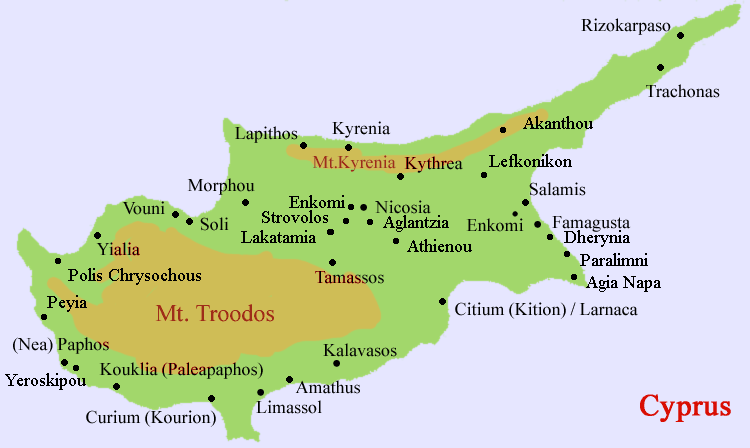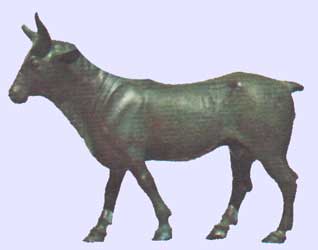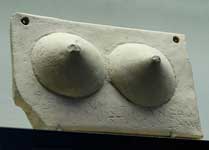|
|
The Ancient History of Cyprus covers the period between 721 BC and the Middle Ages. Assyrian Period The first written source shows Cyprus under Assyrian rule. A stela found in 1845 in Kition commemorates the victory of king Sargon II (721-705 BC) in 709 over the seven kings in the land of Ia', in the district of Iadnana or Atnana. The former is supposedly the Assyrian name of the island, while some authors take the latter to mean Greece (the Islands of the Danaoi). There are other inscriptions referring to Ia' in Sargon's palace at Khorsabad. The ten kingdoms listed by an inscription of Esarhaddon in 673/2 BC have been identified as Soli, Salamis, Kition, Amathus, Kourion, Paphos and on the coast and Tamassos, Ledrai, Idalion and Chytroi in the interior. Later inscriptions add Marion, Lapithos and Kerynia (Kyrenia). The city-kingdoms began to strike their own coins around 500 BC, using the Persian weight system. The City-Kingdoms Cyprus gained independence around 669/663. Cemeteries of this period are mainly rock-cut tombs. They have been found, among others, at Tamassos, Soloi, Patriki and Trachonas. The rock-cut 'Royal' tombs at Tamassos, built ca. 600 BC imitate wooden houses. The pillars show Phoenician influence. Some graves contain remains of horses and chariots. In 570, the Island was conquered by Egypt under Amasis. The main deity on the Island was the Great Goddess, Phoenician Astarte, later known under the Greek name of Aphrodite, who was called 'the Cypriote' by Homer. Paphian inscriptions call her the Queen. Pictures of Aphrodite appear on coins of Salamis as well, demonstrating that her cult was of more than local importance. The king of Paphos was high Priest of Aphrodite as well. Other Gods venerated were the Phoenician Anat, Baal, Eshmun, Reshef, Mikal and Melkart and the Egyptian Hathor, Thoeris, Bes and Ptah, as attested by amulets. Animal sacrifices are attested by terracotta-votives. The Sanctuary of Aya Irini contained over 2000 figurines. Statues in stone show a mixture of Egyptian and Greek influence. Men often wear Egyptian whigs and Assyrian-style beards. Armour and dress show western Asiatic elements as well.
Stele, Marion , 5th century BC Except for Amathus, the Kingdoms of Cyprus, took part in the Ionian rising in 499 BC, following the lead of Onesilos of Salamis. The Persians crushed the Cypriote armies and laid siege to the fortified towns in 498 BC. In Paphos, remains of a Persian siege-ramp and counter-tunnels have been excavated at the North-gate. Soloi surrendered after a five-month siege. Around 450, Kition annexed Idalion with Persian help. The importance of Kition increased again when it acquired the Tamassos copper-mines. The Teucrid dynasty of Salamis had been displaced by an Phoenician exile around 450 BC. Only in 411 did Evagoras I regain the throne of Salamis. At the beginning of the 4th century BC, he took control of the whole island and tried to gain independence from Persia with Athenian help. Ca. 380 a Persian force besieged Salamis . Evagoras was forced to surrender, but stayed king of Salamis until he was murdered in 374. Together with Egypt and Phoenicia, Cyprus rebelled again in 350 BC, but the upraising was crushed by Artaxerxes in 344.
Bronze Cow, Vouni, 5th Century BC The Greek alphabet was introduced by Evagoras I. of Salamis, in other parts of the island, the Phoenician script (Kition) or the Cypriot syllabic alphabet was still used, either for inscriptions in Greek (Arcadic) or in the so called Eteo-Cypriot language (Amathus). Only during the 4th century, the Cypriot gods became known under Greek names. Anat, who had a temple at Vouni was called Athena, Astarte Aphrodite, the main male God as Zeus. Reshef and Hylates were equated with Apollo, Eshmun with Asklepios.
Apollo Hylates Sancturary, Palaestra Curium Full Hellenisation only took place under Ptolemaic rule. Phoenician and native Cypriot traits disappeared, together with the old Cypriot syllabic script. A number of cities were founded during this time, e.g. Arsinoe that was founded between old and new Paphos by Ptolemy II. Vouni Persian period In 526 BC, the Persians conquered the island. Some years later, the island was incorporated into the 5th Satrapy (Ionia), and East Greek influence can be seen in the Cypriot material culture. The Persians did not interfere in internal affais, the city-kingdoms continued to strike their own coins and to wage war among each other. Royal palaces have excavated in Palaepaphos and in Vouni in the territory of Marion on the North coast. They closely follow Persian examples like Persepolis. Vouni, on a hill overlooking the bay of Güzelyurt was built around 520 BC and destroyed in 380. It contained Royal audience chambers (liwan), open courtyards, bathhouses and stores. The towns were fortified with mudbrick walls on stone foundations and rectangular bastions. The houses were constructed of mud-bricks as well, public buildings were faced with ashlar. The Phoenician town of Carpasia near Dipkarpaz had houses built of rubble masonry with square stone blocks forming the corners. Temples and sanctuaries were mainly built according to Phoenician templates. Soloi had a small temple with a Greek plan. During the Persian rule, Ionian influence on the sculptures intensified, copies of Greek korai appear, as well as statues of men in Greek dress. Naked kouroi, common in Greece, are extremely rare. In the pottery, definite local styles develop, some Greek pottery was imported as well. The most important obligation of the kings of Cyprus to the Shah of the Shahs of Persia was the payment of tribute and the supply of armies and ships for his foreign campaigns. Thus when Xerxes in 480 B.C. invaded Greece, Cyprus contributed 150 ships to the Persian army. Evagoras I (435-374 B.C.) was an important pro-Greek king of Cyprus. He tried to unite the cities of Cyprus. He met resistance on the parts of the kings of Kition, Amathus and Soli who fled to the great king of Persia in 390 B.C. requesting him to prevent Evagoras from carrying out his plans. Evagoras also didn't receive much help from Athenians and failed and had to flee the country. Hellenistic Period During the siege of Tyre, the Cypriot Kings went over to Alexander of Macedon and supported him with ships. In 321 four Cypriot kings sided with Ptolemy I Soter and defended the island against Antigonos. Ptolemy lost Cyprus to Demetrios Poliorketes in 306 and 294 BC, but after that it remained under Ptolemaic rule till 58 BC. It was ruled by a governor from Egypt and sometimes formed a minor Ptolemaic kingdom during the power-struggles of the 2nd and 1st centuries. Strong commercial relationships with Athens and Alexandria, two of the most important commercial centres of antiquity, developed. Roman occupation Cyprus became a Roman province in 58 BC, according to Strabo because Publius Clodius Pulcher held a grudge against Ptolemy and sent Marcus Cato to conquer the island after he had become tribune. Mark Antony gave the island to Cleopatra VII of Egypt and her sister Arsinoe, but it became a Roman province again after his defeat at the Battle of Actium (31 BC) in 30 BC. From 22 BC it was a senatorial province, after the reforms of Diocletian it was placed under the Consularis Oriens. The island suffered great losses in the Jewish rising of AD 115/116, when it is believed that 240,000 Greek and Roman civilians were killed. Though probable that the number massacred is greatly inflated, there were few or no Roman troops stationed on the island to suppress the insurrection as the rebels reaped havoc. After forces were sent to Cyprus and the uprising was put down, law was passed that no Jew was permitted to land on Cyprian soil, not even in case of ship wreck. Several earthquakes led to the destruction of Salamis at the beginning of the 4th century, at the same time drought and famine hit the island. Christianization The apostle Paul is reported to have converted the people of Cyprus to Christianity. St. Barnabas was supposed to have founded the Cypriote church, underpinning claims for ecclesiastical independence from Antioch. According to the apocryphal Acts of Barnabas, Barnabas carried a copy of the Gospel with him, which he had written and that was buried with him, and later unearthed after a dream by Archbishop Anthemius of Salamis. At least three Cypriote bishops (sees of Salamis, Tremithus and Paphos) took part at the First Council of Nicaea in 325, twelve at the council of Sardica in 344. In 400, the Metrolitan see was located at Salamis (Constantia). Early Cypriote Saints include St. Heracleidius, St. Spiridon, St. Hilarion and St. Epiphanius. A fragment of the true cross was deposited by St. Helena at Tokhni, the cross of the penitent thief at Stavrovouni, which helped to relieve a terrible drought. During the 5th century AD, the church of Cyprus achieved its independence from the Patriarch of Antioch at the Council of Ephesus in 431. Emperor Zeno granted the archbishop of Cyprus the right to carry a sceptre instead of a pastoral staff. Timeline c.1700 BC Aphrodite Ourania comes to Cyprus. c.1675 BC Aphrodite Zeia Kypris is born to Zeus-Kypros and Dione. c.1500 Pygmalion Belis comes to the city of Amathus in Cyprus, marries Galatea and begets Paphos. c.1460 BC Paphos Pygmaliotis is known in Cyprus. c.1420 BC Adonis Phoenikides is known. c.1405 BC Kinyras Paphitis founds the city of Paphos but is seduced by his own daughter Smyrna, and begets a son Adonis. c.1385 BC Laodice, daughter of Kinyras marries Elatus Arcades of Arcadia and gives birth to five sons, Aepytus, Pereus, Cyllen, Ischys, and Stymphalus. c.1355 BC Pygmalion (father unknown) rules at Paphos. Sandocus Astynoudes marries Pharnace, daughter of Megassares, king of Hyria in Celixia and begets Kinyras. c. 1310 BC Kinyras Sandocou, having married Metharme, daughter of Pygmalion, becomes king of Cyprus and begets Oxyporus and Adonis, and the daughters, Orsedice, Laogore and Braesia. c.1220 BC Kinyras (father unknown) rules at Paphos. 1201 BC Kinyras sends Agamemnon Atrides 50 ships, 49 of them made of clay. 1183 BC Agapenor Ancaeou, the king of Arcadia rebuilds Paphos and builds a sanctuary to Aphrodite at Palaepaphos. c.1180 Teucer Telemonides marries a daughter of Kinyras, begets a daughter Asteria and founds Salamis. c.1160-unknown time BC Laodice, a descendant of Agapenor sends a robe as a gift for Athena Alea in Tegea. 1150 BC Demophon Thesides, the king of Athens dies in Cyprus. c.1000-600 BC Euclus foretells of the birth of Homer to Themisto, a native of Salamis. Greek Archaic period 724 BC The Tyrian king Eleuleus’ attempt to invade Cyprus results in the Assyrians laying siege to Tyre after being called to assist the Cypriots. c.680 BC Ten Cypriot kings, including Pylagoras king of Chytroi, Eteander king of Paphos and Damasus king of Kurion assist Esarhaddon, king of Assyria in his campaign against Egypt. c.470 BC Amasis compels Cyprus to pay tribute to Egypt after becoming the first man to take it by force. c.568-522 BC Evelthon is king of Salamis. c.522-511 BC Siromas rules at Salamis. c.511-500 BC Chersis Evelthonides rules at Salamis. c.500-493 BC Gorgus Chersides rules at Salamis. 493-492 BC Onsilus the younger brother of Gorgus rules at Salamis and together with other Cypriot kingdoms revolts against the Persians. 492 BC Gorgus restored at Salamis. 480-465 BC Philaon rules at Salamis. 465-450 Nicodemus rules at Salamis. c.450 Lacharidas rules at Salamis. c.450 Evergetis rules at Salamis. c.445 A Phoenician tyrant usurps the throne of Salamis. c.420-411 BC Abdemon, the king of Tyre occupies Salamis. 411-374 Evagoras Teukrides takes back Salamis and then conquers Tyre and other parts of Phoenicia and then all of Cyprus. 374-368 BC Nicocles 368-351 Evagoras II 351-332 Pnythagoras fights at sea as an ally of Alexander in the siege of Tyre. Bible and Jewish sources Cyprus is mentioned by biblical historian Flavius Josephus as being settled by Kittim, son of Javan, grandson of Japheth. "Cethimus possessed the island Cethima: it is now called Cyprus; and from that it is that all islands, and the greatest part of the sea-coasts, are named Cethim by the Hebrews: and one city there is in Cyprus that has been able to preserve its denomination; it has been called Citius by those who use the language of the Greeks, and has not, by the use of that dialect, escaped the name of Cethim." AotJ I:6. c.1560 BC Kethimus (Kinyras or Kypros) rules over Cyprus according to the Bible. Retrieved from "http://en.wikipedia.org/wiki/Ancient_Greek_history_of_Cyprus" Literature
Roman Imperial Provinces, 120 AD Achaea | Aegyptus | Africa | Alpes Cottiae | Alpes Maritimae | Alpes Poenninae | Arabia Petraea | Armenia Inferior | Asia | Baleares | Britannia | Bithynia | Cappadocia | Cilicia et Cyprus | Commagene | Corsica et Sardinia | Creta et Cyrenaica | Dacia | Dalmatia | Epirus | Galatia | Gallia Aquitania | Gallia Belgica | Gallia Lugdunensis | Gallia Narbonensis | Germania Inferior | Germania Superior | Hispania Baetica | Hispania Tarraconensis | Lusitania | Italia | Iudaea | Lycaonia | Lycia | Macedonia | Mauretania | Moesia | Noricum | Numidia | Osroene | Pannonia | Pamphylia | Pisidia | Pontus | Raetia | Sicilia | Sophene | Syria | Thracia
Retrieved from "http://en.wikipedia.org/"
 |
|
||||||||||||||
|
|




